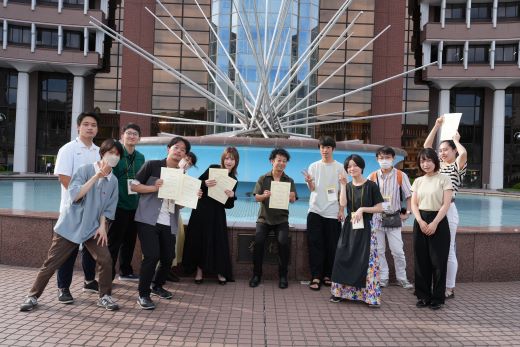[School of Interdisciplinary Mathematical Sciences] Professor MIYASHITA Homei and MURAKAMI Shuto, OTOMO Chihiro, and FUKAIKE Miku win the Outstanding Research Award at Entertainment Computing 2023 for "TTTV3"
Oct. 02, 2023



At the Information Processing Society of Japan EC2023 (21st Entertainment Computing), held at Tokyo University of Technology from August 30 to September 2, 2023, Professor MIYASHITA Homei of the Department of Frontier Media Science gave a podium presentation about his research titled "TTTV3," co-authored with fourth-year students from the same department, MURAKAMI Shuto, OTOMO Chihiro, and FUKAIKE Miku, and won the Outstanding Research Award. Including this Outstanding Research Award, MIYASHITA Homei Laboratory won a total of six awards at the conference.
TTTV3 is the latest version of the taste display that Professor MIYASHITA has been developing, distinguished by its accuracy in reproducing even differences in production areas. On August 31 and September 1, demonstrations of "Taste expression of wine using TTTV3" (Demo Grand Prize) and "Quantification and reproduction of taste differences in cacao from different production areas using pure substances" (Demo Excellence Award) were conducted, and its high reproducibility was well received.
On September 2, Professor MIYASHITA delivered a podium presentation, explaining the use of not only taste sensors for quantification but also evaluation and supervision by professionals, and that the taste was approximated using multiple solutions for a single taste and "taste subtraction" is used to mitigate specific tastes by suppressing acidity with a neutralizing agent and masking effects by other tastes.
Furthermore, TTTV3 is equipped with a feature that enables it to estimate and generate taste profiles based on input, either by voice commands stating dish names or by displaying photos of dishes to a webcam, all powered by LLM. In this podium presentation, Professor MIYASHITA electronically distributed the Manual for Interacting with LLM to Explore Taste without TTTV3 to the audience, allowing them to experience AI-based taste exploration.
・MIYASHITA Homei, MURAKAMI Shuto, OTOMO Chihiro, FUKAIKE Miku. TTTV3 (Transform The Taste and reproduce Varieties): Seasoning mechanism that reproduces differences of tastes in production areas and varieties, and taste expression by LLM, Entertainment Computing Symposium Proceedings, Vol.2023, pp.236-243, 2023
Overview: The TTTV3 can control tastes in 0.02 ml increments, more finely than professional cooks. It features high taste reproducibility by using multiple liquid solutions for one taste. Moreover, it can also “subtract tastes”, or make a certain taste lighter than that of the original food, by adding an alkaline substance to neutralize the taste, utilizing taste modulators, or using the masking effect of another taste.
You can input dish names through a microphone or display images to a webcam, and LLM can estimate and produce the taste accordingly. Furthermore, you can interact with LLM to adjust the taste, enabling exploration of unfamiliar flavors within a wide taste spectrum.
≪Japanese version≫
TTTV3 is the latest version of the taste display that Professor MIYASHITA has been developing, distinguished by its accuracy in reproducing even differences in production areas. On August 31 and September 1, demonstrations of "Taste expression of wine using TTTV3" (Demo Grand Prize) and "Quantification and reproduction of taste differences in cacao from different production areas using pure substances" (Demo Excellence Award) were conducted, and its high reproducibility was well received.
On September 2, Professor MIYASHITA delivered a podium presentation, explaining the use of not only taste sensors for quantification but also evaluation and supervision by professionals, and that the taste was approximated using multiple solutions for a single taste and "taste subtraction" is used to mitigate specific tastes by suppressing acidity with a neutralizing agent and masking effects by other tastes.
Furthermore, TTTV3 is equipped with a feature that enables it to estimate and generate taste profiles based on input, either by voice commands stating dish names or by displaying photos of dishes to a webcam, all powered by LLM. In this podium presentation, Professor MIYASHITA electronically distributed the Manual for Interacting with LLM to Explore Taste without TTTV3 to the audience, allowing them to experience AI-based taste exploration.
・MIYASHITA Homei, MURAKAMI Shuto, OTOMO Chihiro, FUKAIKE Miku. TTTV3 (Transform The Taste and reproduce Varieties): Seasoning mechanism that reproduces differences of tastes in production areas and varieties, and taste expression by LLM, Entertainment Computing Symposium Proceedings, Vol.2023, pp.236-243, 2023
Overview: The TTTV3 can control tastes in 0.02 ml increments, more finely than professional cooks. It features high taste reproducibility by using multiple liquid solutions for one taste. Moreover, it can also “subtract tastes”, or make a certain taste lighter than that of the original food, by adding an alkaline substance to neutralize the taste, utilizing taste modulators, or using the masking effect of another taste.
You can input dish names through a microphone or display images to a webcam, and LLM can estimate and produce the taste accordingly. Furthermore, you can interact with LLM to adjust the taste, enabling exploration of unfamiliar flavors within a wide taste spectrum.
≪Japanese version≫


